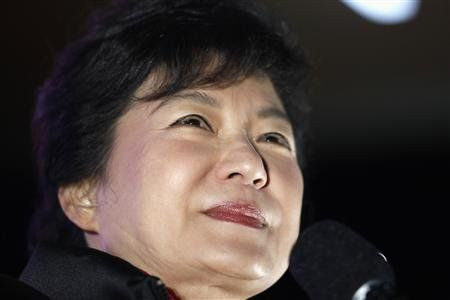If You Want To Rule An Asian State As A Woman, You Better Have a Father Or Husband In Charge First
Females In Asia, Like Males Everywhere, Find Nepotism Rules

The election and swearing-in of Park Geun-hye as South Korea’s first female president marks a historic moment for the East Asian country and U.S. ally.
While that may sound like a revolutionary development, it actually continues a less noble tradition in Asia -- the rise to power of women who are the wives or daughters of powerful male leaders.
Park Geun-hye, 61, who defeated liberal opponent Moon Jae-in in the general election in December on a tough stance against North Korea and a focus on the economy, did not get to the top entirely on her own.
She is the daughter of Park Chung-hee, the military dictator who ruled South Korea with an iron fist from 1961 to 1979. (Park Chung-hee was assassinated by the chief of the country’s central intelligence agency. Park Geun-hye’s mother was murdered in 1974 by a North Korean assassin who was aiming for her father.)
Such family connections, while frequently dangerous, are of crucial importance to attaining power across Asia, even in “democratic” states like South Korea.
Consider the case of the world’s biggest democracy India -- the Congress Party has essentially ruled that country since its founding in 1947 when Jawaharlal Nehru was elected prime minister. His daughter, Indira Gandhi (no relation to Mahatma Gandhi) became India’s first woman prime minister in 1966, serving until 1977; then serving a second term from 1980 to 1984, before an assassin’s bullet ended her life.
Indira’s daughter-in-law, the Italian-born Sonia, widow of Prime Minister Rajiv, is now the head of the Congress Party and the most powerful politician in India.
India’s neighbor and chief rival, Pakistan, also has a similar story of blood and dynasty.
Pakistan’s first (and thus far only) female prime minister was Benazir Bhutto, the daughter of Zulfikar Ali Bhutto, who served as the country’s prime minister until he was overthrown and then executed in 1979 by Gen. Zia al-Haq.
Benazir served two terms as prime minister (1988-1990 and 1993-1996).
Benazir herself was assassinated in 2007, during the middle of yet another election campaign.
Today, her husband, Asif Ali Zardari, is the president of Pakistan, while her son, Bilawal Bhutto Zardari, is poised to follow in his famous parents’ footsteps. Only 25 years old, Bilawal is already co-chairman of his family’s ruling Pakistan People’s Party.
Bilawal has two younger sisters, Bakhtawar and Asifa – conceivably they too could have political careers in their future should they wish (or if circumstances dictate such an event).
In other Asian countries, we have seen similar family sagas.
More than 50 years ago, Sirimavo Bandaranaike of Sri Lanka became the first woman leader of a modern state, taking over as prime minister of then-Ceylon in 1960. She would serve as the country’s leader three separate times: 1960-65, 1970-77, and 1994-2000.
However, she only attained power after her husband, prime minister Solomon Bandaranaike, was assassinated by a Buddhist monk in 1959.
And it didn’t stop there.
Sirimavo’s daughter Chandrika Kumaratunga served as president of Sri Lanka from 1994 to 2005; while Sirimavo’s son, Anura Bandaranaike, is a former speaker and cabinet minister.
Similarly, the current prime minister of Bangladesh, Sheikh Hasina, is none other than the daughter of Sheikh Mujibur Rahman, who served as the first president of Bangladesh, after it broke away from Pakistan following a civil war in 1971.
In the Philippines, the country’s first female president, Corazon Aquino, stepped in to fill the vacuum created by the assassination of her husband (and presidential hopeful) senator Benigno "Ninoy" Aquino Jr. in 1985. Corazon served a president from 1986 to 1992. Her son Benigno "Noy-noy" Aquino III is president now.
His predecessor Gloria Macapagal-Arroyo, who served as president from 2001 and 2010, was the daughter of Diosdado Macapagal, who ruled as president in the early 1960s.
Megawati Sukarnoputri, who served as the first female president of Indonesia from 2001 to 2004, was the eldest daughter of Sukarno, the country’s first president, who served in the turbulent 1960s.
The current prime minister of Thailand, Yingluck Shinawatra, is not only the first female of her country to hold that post, but she is also the younger sister of former Prime Minister Thaksin Shinawatra, who was removed by a military coup in 2006. (However, Yingluck is widely believed to be a puppet for her exiled brother).
Jamie Chandler, a political scientist at Hunter College in New York, noted that the fact that many Asian women leaders come from prominent political families is not unique to their gender.
“Dynastic politics is a prominent part of the political systems of many Asian countries,” he said.
“There are an equal number of male leaders whose families built long-term careers in public service.”
Still, women politicians continue to face difficulties breaking into the highest levels of politics, even in the West.
“Part of it is driven by culture. It's only been recently that women have started to move to prominent leadership roles in business and other industries, and also because women have low participation rates in government, due in a large part to legal, cultural, and socioeconomic barriers,” Chandler explained.
“It's only been in the last few decades where women have had better opportunities to win elected offices in the Western democracies -- and in the last 10 to 12 years where more and more women have been elected to the U.S. Congress.”
Indeed, some prominent Western countries, including the U.S., France, Italy and Spain, have never had a woman leader, while Britain and Germany have only had one each.
© Copyright IBTimes 2025. All rights reserved.





















